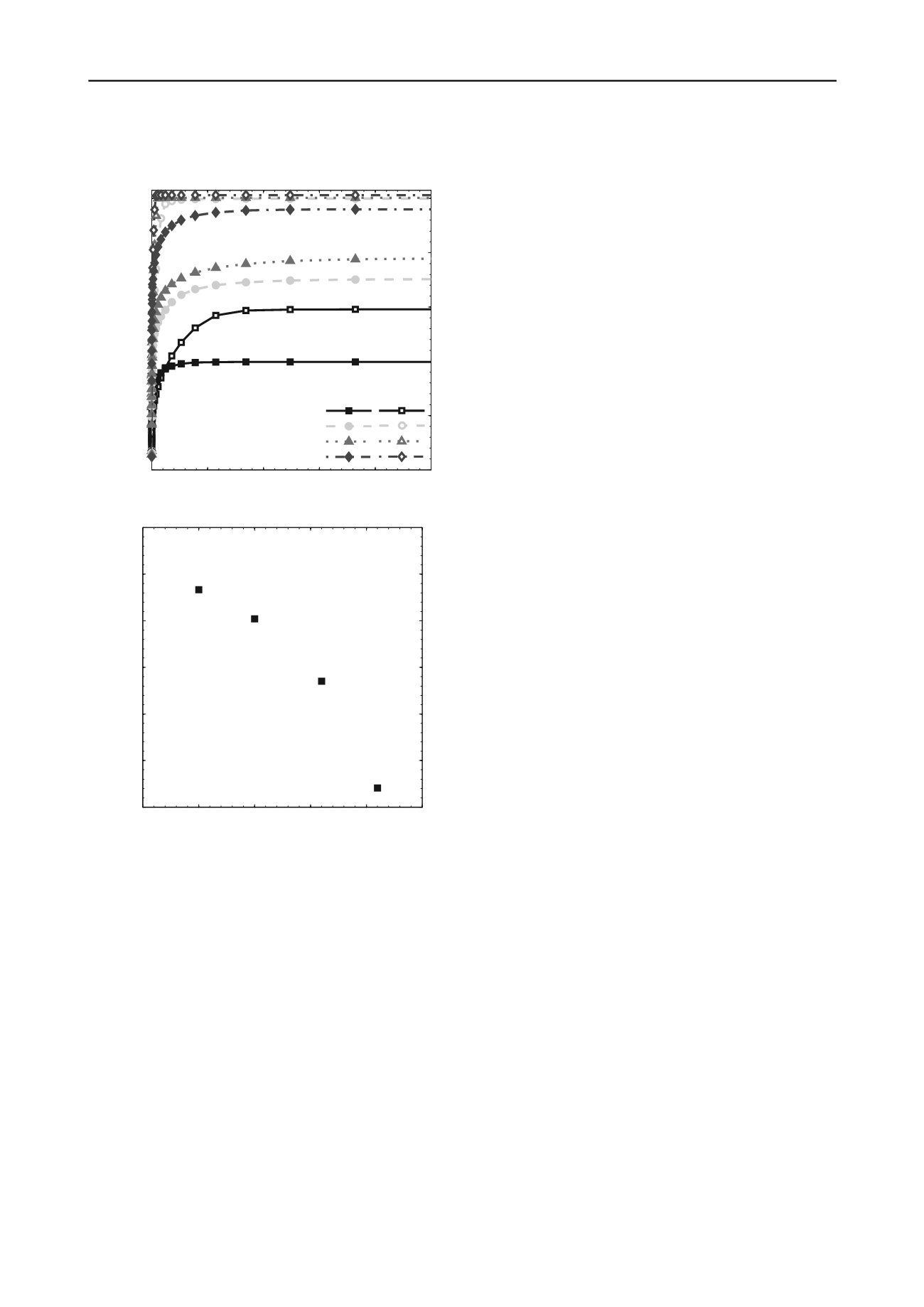
1190
Proceedings of the 18
th
International Conference on Soil Mechanics and Geotechnical Engineering, Paris 2013
contents, the GCL hydrated under 100 kPa confining stress will
be at an increasingly higher degree of saturation.
2. For a given foundation soil moisture content, a GCL
hydrating at a higher confining stress will achieve a
higher degree of saturation than an unconfined GCL.
The magnitude of this difference is a function of the
foundation moisture content. This is due to the change in
shape of the WRC resulting from the decrease in
saturated VWC and increase in air entry value.
0
10
20
30
40
50
0
0.2
0.4
0.6
0.8
1
GCL degree of saturation, Sr (-)
Time (weeks)
Silt GWC=5%
Silt GWC=10%
Silt GWC=16%
Silt GWC=21%
GCL
2kPa
GCL
100kPa
0
5
10
15
20
25
1
1.1
1.2
1.3
1.4
1.5
Ratio of Sr
100kPa
/Sr
2kPa
(-)
Foundation GWC (%)
The objective of the parametric study was to assess the likely
impact of confining stress on the hydration of GCLs in landfill
liner applications. The results of these analyses indicate that
confinement will play a significant role on both the rate and
magnitude of hydration in GCLs, warranting further laboratory
studies to experimentally quantify the WRCs for typical GCLs
at a higher confining stress. In the absence of this specific
information, the analyses indicate that the use of WRCs defined
for GCL hydration at low confining stress will be generally
conservative (i.e. underpredict) the rate and magnitude of
hydration for GCLs at higher confining stresses.
5 REFERENCES
Beddoe, R.A., Take, W.A. and Rowe, R.K. 2011. Water retention
behaviour of geosynthetic clay liners.
ASCE Journal of
Geotechnical and Geoenvironmental Engineering
137(11),
1028-1038
Chappel, M.J., Brachman, R.W.I., Take, W.A., and Rowe, R.K. 2011.
Large-scale quantification of wrinkles in a smooth, black, HDPE
geomembrane.
ASCE Journal of Geotechnical and Geoenv.
Engineering
137(6), 671-679.
Fredlund, D.G. and Pham, H.Q. 2006. A volume-mass constitutive
model for unsaturated soils in terms of two independent stress state
variables.
Proceedings of Unsaturated Soils 2006,
105-133.
Fredlund, D.G. and Xing, A. 1994. Equations for the soil-water
characteristics curve.
Canadian Geotechnical Journal
31(4),
521–532.
GeoStudio 2007. Version 7.20. Geo-Slope International Ltd, Calgary,
Alberta, Canada.
Lake, C.B. and Rowe, R.K.R. 2000. Swelling characteristics of
needlepunched, thermally treated geosynthetic clay liners.
Geotextiles and Geomembranes
18, 77-101.
Pelte, T., Pierson, P. and Gourc, J.P. 1994. Thermal analysis of
geomembranes exposed to solar radiation.
Geosynthetics
International
1(1), 21-44.
Petrov, R.J. and Rowe, R.K. 1997. GCL chemical compatibility by
hydraulic conductivity testing and factors impacting its
performance
Canadian Geotechnical Journal
34(6), 863-885.
Figure 5. Effect of GCL confinement on hydration: a) GCL
degree of saturation, Sr versus time and b) ratio of Sr
100kPa
/Sr
2kPa
versus foundation gravimetric water content.
Rayhani, M.T., Rowe, R.K., Brachman, R.W.I., Take, W.A. and
Siemens, G.A. 2011. Factors affecting GCL hydration under
isothermal conditions.
Geotextiles and Geomembranes
29(6),
525–533.
Rowe, R.K., Chappel, M.J., Brachman, R.W.I. and Take, W.A. 2012.
Field study of wrinkles in a geomembrane at a composite liner test
site.
Canadian Geotechnical Journal
49(10), 1196-1211.
4 CONCLUSIONS
The lack of unsaturated water retention curve data for GCLs at
high confining stresses has made the assessment of the effect of
confining stress on the magnitude and rate of hydration
currently unclear. In this paper, existing data describing the
water retention behaviour of GCLs at low confining stress has
been combined with data describing the consolidation behaviour
of saturated GCLs to perform a numerical sensitivity analysis to
investigate whether higher confining stresses are likely to have
a practical impact on the hydration behaviour of GCLs in
landfill design.
Rowe, R.K. and Hosney, M.S. 2013. Laboratory investigation of GCL
performance for covering arsenic contaminated mine wastes
Geotextiles and Geomembranes
(in review).
Rowe, R.K., Rayhani, M.T., Take, W.A., Siemens, G. and Brachman,
R.W.I. 2011. GCL hydration under simulated daily thermal cycles.
Geosynthetics International
18(4), 196–205.
Siemens, G.A., Take, W.A., Rowe, R.K. and Brachman, R.W.I. 2012.
Numerical investigation of transient hydration of unsaturated
geosynthetic clay liners.
Geosynthetics International
19(3),
232-251.
Southen, J.M. and Rowe, R.K. 2007. Evaluation of the water retention
curve for geosynthetic clay liners.
Geotextiles and Geomembranes
25, 2-9.
The numerical analyses indicate:
1. GCLs hydrating at high confining stresses will hydrate
faster than a GCL at lower confining stresses for lower
suction ranges. GCLs at higher confining stresses have
the benefit of having a higher suction where the
saturated hydraulic conductivity is achieved and their
thinner thickness results in a shorter flow path distance.


